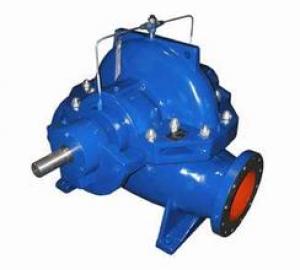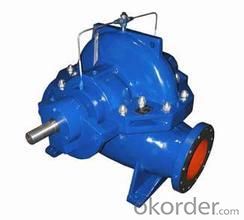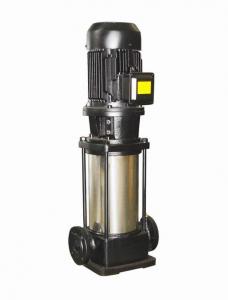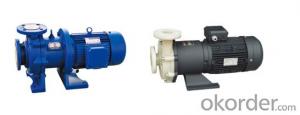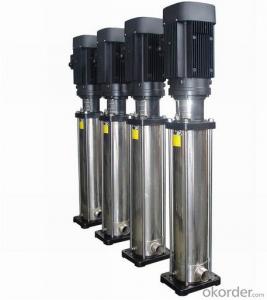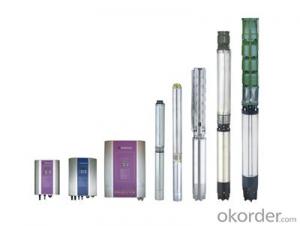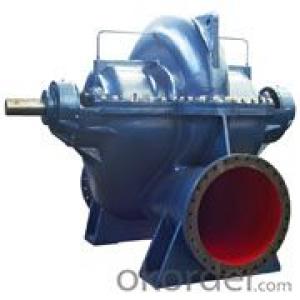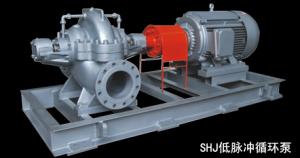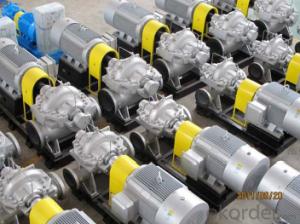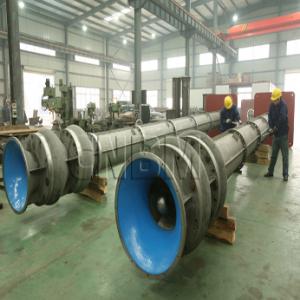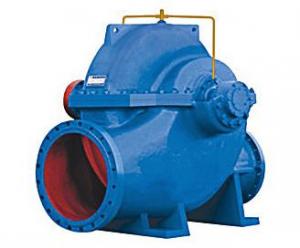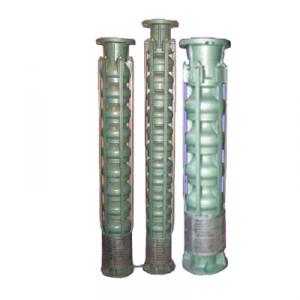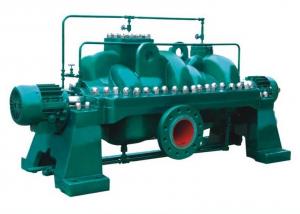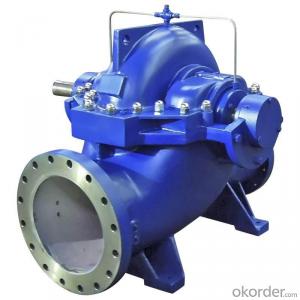Double Suction Centrifugal Pump
- Loading Port:
- Shanghai
- Payment Terms:
- TT or L/C
- Min Order Qty:
- 1 Set unit
- Supply Capability:
- 1000 Sets Per Year unit/month
OKorder Service Pledge
Quality Product, Order Online Tracking, Timely Delivery
OKorder Financial Service
Credit Rating, Credit Services, Credit Purchasing
You Might Also Like
Single-stage Single-suction Horizontal Centrifugal Pump 100 : Diameter of pump inlet and outlet (mm) 160 : Nominal diameter of impeller (mm) I
- Q: QDX is a submersible pump. What does "X" mean?
- It should be small.There is no "downdraft" term;Do not say submersible pumps do not suck, what kind of pump is not on suction, or left and right suction
- Q: Our CRN series pumps used in the 414V 480V 60Hz 60Hz power supply, what would be the effect? Is not the head can be reduced, there is no water pump and lift what voltage relationship?
- Our CRN series water pump 1, 480V 60Hz in 414V 60Hz power supply, won't have what effect, only voltage drop corresponding to the current rise. Water pump head will not decrease.2, the water pump voltage and head have no direct corresponding relationship.
- Q: I have a pontiac grand am 1996 v6 with a 3.1L 3100 SFI engine. I have a coolant leak and I think it's coming from the water pump. When the car is cool and then turned on, about 4 to 9 minutes into warming up, coolant is hitting a belt and spraying out of the car's front end. When this is happening I see that there is coolant dripping off of the waterpump housing. The coolant started to spray everywhere about 15 seconds before the radiator fan kicked in. Why would this happen when first warming up only? Can a defective thermostat cause this to happen?
- It;s the water pump.
- Q: So I purchased this car last week. It ran great for three days until it started leaking water so much that it caused it to over heat. My uncle checked it out for me and said it was either the seal or the water pump. Yesterday we replaced the seal and still leaking water. So we now know it is the water pump. My uncle and every mechanic I know has turned down the job saying it is too much work. I even called two small shops yesterday and got turned down saying it was too much work. It is Sunday so most mechanics are closed. Can anyone give me an estimate on how much this will cost. The problem is everyone is saying that the pump is located inside the timing belt which is hard to put back after replacing the pump. Anyone ever have this repair done before or know a price range. I am a college student and need this car running asap and only got about $500 i can put into it. It is a V6 engine.Thanks
- I okorder /... any one with a Haynes manual and a lot patience can do it, so if your short on money you may just have to ask every friend and family you know if someone can do it for you. Just make sure its the water pump. It will be leaking out from the timing cover, if its leaking from anywhere else it not the water pump (assuming you have a Mitsubishi engine. if it is the Chrysler V-6 it will be leaking from the water pump itself, and takes a whole 30 mins to change, do it your self).
- Q: When did the pump start?
- The promotion of water is very important to human life and production. There are various ancient water appliances, such as Egypt's chain pump (seventeenth Century BC), China shadoof (seventeenth Century BC), Burton (Eleventh Century BC) and water (first Century ad). The famous spiral rods invented by Archimedes in the third Century BC can lift water to a few meters in a steady and continuous way, and the principle is still used by modern screw pumps.In 200 BC, the ancient Greek fire pump craftsmen invented by Kurt Siby Lucius is a kind of piston pump has the most original, the main components of a typical piston pump piston pump, but only after the steam engine was developed rapidly.1840~1850 years, the United States invented Worthington pump cylinder and steam cylinder opposite, the direct impact of the piston pump, marking the formation of modern piston pumps. Nineteenth Century was the climax of the development of piston pumps, which were already used in a variety of machines, such as water presses. However, with the rapid increase in water demand, from 1920s, the piston pumps with low speed and large flow were gradually replaced by high-speed centrifugal pumps and rotary pumps. But in the field of high pressure and small flow, reciprocating pump still occupies the main position, especially diaphragm pump and plunger pump have their own advantages and are used more and more.
- Q: i have a 2003 dodge neon and my thermostat keeps rising to the highes level setting off the indicator (its not broken) i did have a leak in the raiditor and it was very notice able..after pacthing is up there was noproblem till yesterday now the thermostat keeps rising i admit the is very little antifreeze in ther and the rest is water but the is the same mixture tha was in the care that it was rinning off for the last three minths i cannot seem to keep the thermostat down my raiditor is in nee of repair but i m wondering if its the water pump does the water pum help regulate engine temperture? ther are no ivsible leaks and no drippiage could it be that i just need to put antifreeze or could it be the water pump or a broken raidiator? help i will give points for best anwser but really i just need help!
- I'd say the most likely thing is the thermostat. It is the most common cause of overheating when there is plenty of water in the system. As you already know, the radiator can leak and make it get hot. You can add water and it will stay cool for awhile, until the water leaks out again. The same can be true of a leaky water pump, heater core, or hose. If there is no leak, or no obvious leak, and the system seems to have enough water in it, but it still gets hot it is more than likely the thermostat. The thermostat blocks off the water from the radiator until the engine warms up. It can be damaged by getting too hot (like when you had a bad radiator) and fail soon after. Other possibilities are an electric cooling fan that isn't working, or a blown head gasket.
- Q: I intend to construct a DIY base camp shower and dish sprayer. I have been searching for an appropriate submersible water pump to plug into a small inverter to a 12-volt cigarette lighter power pack (car jump starter). I need to attach adapters for a hose with a shower head and think that approximately 1+ gallons of draw per minute is practical. I would possibly use a five to six-gallon reservoir, heating water on a car-camping propane stove. My biggest concern is amp draw. Maxi-Jet NJ-400 Submersible Utility Pump, $21, is a powerful aquarium pump with an adjustable flow up to 1.8 gpm.
- Aquarium Water Pump
- Q: A rectangular tank that is 2 feet long, 3 feet wide and 6 feet deep is filled with a heavy liquid that weighs 80 pounds per cubic foot. How much work is done pumping all of the liquid out over the top of the tank?How much work is done pumping all of the liquid out of a spout 5 feet above the top of the tank?How much work is done pumping two-thirds of the liquid out over the top of the tank?How much work is done pumping two-thirds of the liquid out of a spout 5 feet above the top of the tank?I thought that math was hard enough and now they added physics..
- Work is force x distance, which is conveniently pounds x feet. Since we are only interested in the height here (as that is the direction we are pumping), we only need to integrate along that path. The differential weight/force being pumped is the volume (LxWxH = 2 x 3 x dH) times the density (80) and the distance is the height that volume is pumped (6 - H). So W = integral( 6 * 80 * dH * (6-H)) from H=0 to 6 W = integral ((2880 - 480H) dH) = 2880H - 240*H^2 = 2880(6) - 240*(6)^2 = 8640 foot-pounds of work. If you are pumping from the spout, replace the 6-H with 11-H, and the answer becomes 23,040 foot-pounds, which makes sense since you have almost tripled the averge height you were lifting. For the 2/3, change the range of the integration to H = 2 - 6, since H = 0 - 2 represents the water at the bottom of the tank that will still be there later. This gives you answers of 3840 and 13,440 foot-pounds respectively, showing that the last couple of feet are the hardest to pump out (because they have the farthest to go...)
- Q: Here are specifications for two water pump sets. I would like to know which one will have more vertical suction.Pump 1:1.5 hp, 98cc Engine, 4 - Strokes RPM 3600 (Engine RPM), Petrol Fuel, Fuel Consumption 700 ml/hour, Delivery (horizontal) 50m, Inlet / Outlet Port (Dia) 1.5x1.5 inches, Output Capacity 48000 Litres / Hour.Pump 2:3.3hp, 163 cc Engine, 4 - Strokes RPM 3600 (Engine RPM), Petrol Start amp; Kerosene Run, Fuel Consumption 700 ml/hour, Delivery (horizontal) 26m, Inlet / Outlet Port (Dia) 2x2 inches Output Capacity 36000 Litres / Hour.which one should I go for.
- The first one appears to have a higher flow rating but neither gives a head figure, which is the maximum height it can work to above the pump. Lift from below a pump is limited to 32ft on any form of water pump; that is the limit water will rise to with a total vacuum above it. A normal pump cannot pull a perfect vacuum so working lift will be somewhat less. The practical limit depends on the pump head in use and it's actual head limit; the total height from the pickup point to the delivery point count as working head. Any kind of centrifugal pump or one which cannot also pump air perfectly will need a foot valve at the base of the inlet pipe and a priming system to fill the pipe and pump body with water before the pump is started. If you expect the water level to be more than 10 - 15ft down, you would be better off with a submersible pump; the only limit then is the head rating which can be just about anything. Get a suitably rated petrol or diesel generator as well (3x the pump power rating) if it must operate independently of mains power.
- Q: When the pump is connected in parallel, will the head and flow change?
- 2 pumps parallel, lift the same, pump head is not stacked?;Answer: the head can not be superimposed, that is, a lift and a pump, but the pumping speed (flow) is two times a taiwan.2 pumps in series, the same flow, pump head is not stacked?.Answer: the head can be superimposed, that is, the pump head is two times as much as a pump, but the pump speed is the same as that of a pump.A pump is a machine that transports liquids or pumps liquids. It will be the prime mover of the mechanical energy or other external energy transfer to the liquid, the liquid energy increase, mainly used to transport liquids including water, oil, alkali liquid, emulsion, suspension emulsion and liquid metal, but also transport liquid, gas mixtures and liquids containing suspended solids. Pump performance of technical parameters are flow, suction, lift, shaft power, water power, efficiency, etc.; according to the different principles of work can be divided into volume pumps, vane pumps and other types. Displacement pump is to use its studio volume changes to transfer energy; vane pump is to use the rotating blade and water interaction to transfer energy, there are centrifugal pumps, axial flow pumps and mixed flow pumps and other types.
Our main products are all kinds of centrifugal pumps, displacement pumps and vacuum pumps, such as oil pumps, multi-phase pumps, single stage and double suction centrifugal pumps, horizontal split case pumps, multistage pumps, axial-flow pumps, mixed flow pumps, petrochemical pump and submersible pumps. Besides, our company also manufactures electric motors and sells electric motors, building materials, indoor decoration materials, civil electric equipment, devices and instrumentation, as well as exports our mechanical and electric products.
1. Manufacturer Overview
| Location | Hunan,China |
| Year Established | 2006 |
| Annual Output Value | US$5 Million - US$10 Million |
| Main Markets | 59.00% Mid East 8.00% North America 8.00% Southern Europe 5.00% Eastern Asia 2.00% Africa 2.00% Oceania 2.00% Southeast Asia 2.00% Western Europe 2.00% South America 2.00% Central America 2.00% Northern Europe 2.00% Eastern Europe 2.00% South Asia 2.00% Domestic Market |
| Company Certifications |
2. Manufacturer Certificates
| a) Certification Name | |
| Range | |
| Reference | |
| Validity Period |
3. Manufacturer Capability
| a) Trade Capacity | |
| Nearest Port | SHANGHAI,GUANGZHOU,DALIAN |
| Export Percentage | 51% - 60% |
| No.of Employees in Trade Department | 6-10 People |
| Language Spoken: | English, Chinese |
| b) Factory Information | |
| Factory Size: | Above 100,000 square meters |
| No. of Production Lines | Above 10 |
| Contract Manufacturing | OEM Service Offered Design Service Offered Buyer Label Offered |
| Product Price Range | High and/or Average |
Send your message to us
Double Suction Centrifugal Pump
- Loading Port:
- Shanghai
- Payment Terms:
- TT or L/C
- Min Order Qty:
- 1 Set unit
- Supply Capability:
- 1000 Sets Per Year unit/month
OKorder Service Pledge
Quality Product, Order Online Tracking, Timely Delivery
OKorder Financial Service
Credit Rating, Credit Services, Credit Purchasing
Similar products
Hot products
Hot Searches
Related keywords

